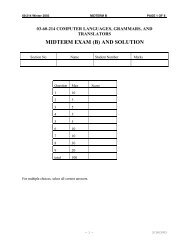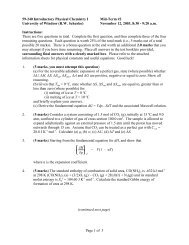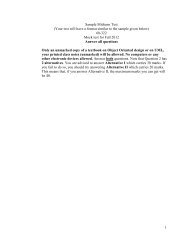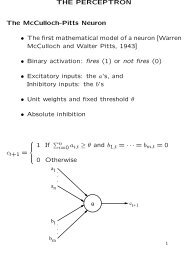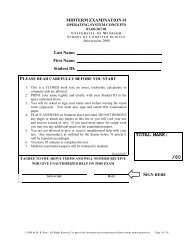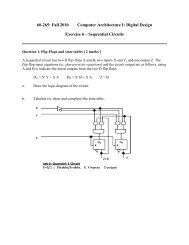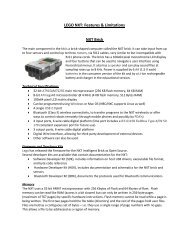You also want an ePaper? Increase the reach of your titles
YUMPU automatically turns print PDFs into web optimized ePapers that Google loves.
Question #1 [15](a) Use the Bohr equation to determine the electronic energy of the first excited state ofB(+4).(b) What is the difference in energy between the ground state and the third excited stateof Be(+3)?(c) What is the ground state electron configuration of bromine?(d) What is the Aufbau principle?(d) What is Hund's rule?Question #2 [25](a) Draw, as carefully as you can the following orbitals: 3p x , 3d x2-y2 , 3d xy , 3d z2 . Be sure toshow the axes and the relative phases (with + or - signs) of ψ.(b) Draw, as carefully as you can graphs of the radial function R(r) for the orbitals: 4p x ,3d x2-y2 , 4d xy , 1s.(c) Sketch bonding and anti-bonding molecular orbitals that can be obtained from linearcombinations of the p y and the d yz orbitals assuming z is the internuclear axis. Label theorbitals.(d) With a drawing, show why the molecular orbitals formed by linear combinations ofthe p z and the d yz are non-bonding. (Again, take the internuclear axis as z.) Write theequation for the overlap integral for these orbitals.(e) With a drawing to specify the orientation of the hybrid orbitals, write appropriateLCAO's for a set of sp 3 d hybrid orbitals.Question #3 [25](a) Use Slater's rules to calculate the effective nuclear charge experienced by a valenceelectron in phosphorus and in sulphur.(b) Does the result you obtained in part (a) suggest that it would be easier to remove avalence electron from phosphorus or from sulphur? Is this what is observedexperimentally? (Yes or No)(c) What is the trend in first ionization enthalpies for the elements of the second period(describe in a sentence or two and draw an approximate plot of ionization energy vs.element)?(d) Explain the general trend in first ionization enthalpies and explain the anomalies inthe trend.
(e) Which of the following would you expect to have the smallest covalent radius:oxygen, fluorine, sulphur or chlorine? Why? (Briefly)(f) Aluminum and gallium have the approximately the same radius in their covalentcompounds. Based on your answer to part (e), you might not have predicted thisobservation. What extra factor(s) help to explain this similarity.Question #4 [30](a) There are two different types of valence MO diagrams for the homonuclear diatomicmolecules of the second period (Li 2 to Ne 2 ). Draw fully labeled diagrams for these twocases and indicate which of the diatomic molecules of the second period are described byeach diagram.(b) Why are the MO's for the diatomic molecules of the second row ordered in these twodifferent ways?(c) What bond orders are predicted using the diagrams in part (a) for the ions N 2 +1 , N 2 -2 .(Hint, the results should be identical for either type of diagram.)(d) Describe how the diagrams from part (a) should be modified to show the MO energylevels of NO + , a heteronuclear diatomic ion? (Briefly.)(e) Draw a Lewis structure for O 2 and using the appropriate molecular orbital energylevel diagram drawn above in part (a) determine the following: on which feature(s) of thedioxygen molecule do the two bonding models agree and on which do they differ. Whichmodel agrees most closely with the experimental observations.Question #5 [25](a) Use an appropriate Born-Haber cycle to estimate the total electron attachmententhalpy for the formation of O -2 (g) from O (g) using the following data (all in kJ/mol):Mg(s) → Mg(g) ∆H° vap = 147O 2 (g) → 2 O(g) ∆H° d = 497Mg(g) → Mg + (g) ∆H° ie = 737Mg + (g) → Mg +2 (g) ∆H° ie = 1450∆H° F (MgO) = -602U 0 (MgO) = -3950(b) Use the Born-Mayer equation to estimate the lattice energy for Mg 2 O using thefollowing data: the radius in Å for Mg is 1.60, the radius for Mg + is 1.16, the radius forMg +2 is 0.72 and the radius for O -2 is 1.40. The Madelung constant for a rock saltstructure is 1.748, the Madelung constant for a fluorite structure is 2.519.
(c) Use the Kapustinskii equation to estimate the lattice energy for Mg 2 O using the datain (b). How do the values compare to each other and how do they compare to the valuelisted for MgO in part (a)?(d) Use the data from (a) and (c) to determine the enthalpy of formation for Mg 2 O.Predict the relative stabilities of Mg 2 O and MgO.Question #6 [15](a) Sketch a unit cell for the structure of rock salt (NaCl) and indicate the coordinationnumber around each cation and each anion.(b) What is the ideal radius ratio r+/r- for the NaCl structure - draw a diagram to showhow it is calculated. (derive it if you have the time, note that sin(45°) = 0.7071)(c) Would the rock salt structure be expected for BeS (r+(Be +2 ) = 0.59 Å, r-(S -2 ) = 1.70Å)? If not, which of the other simple structures might be observed?(d) Lithium fluoride crystallizes with the rock salt structure. Should it? (rLi + = 0.90 Å, rF -= 1.19 Å).Question #7 [30]The nitrate anion NO 3 -1 and sulfur trioxide SO 3 have the same number of valenceelectrons.(a) Draw Lewis structures for each of these molecules and indicate the average bondorder for the bonds from the central atom to the oxygen atoms.(b)Use VSEPR theory and VBT to describe the bonding in NO 3 -1 and SO 3 .(c) Construct an MO diagram for the σ-bonding in NO 3 -1 (the diagram for SO 3 isessentially identical). For simplicity, make the SALCs from the 2s orbitals on the Oatoms.(d) Construct MO diagrams for the π-bonding in in NO 3 -1 and SO 3 and indicate the mostimportant difference between the diagrams. For simplicity, use only the 2p z atomicorbitals on the O atoms to make the SALCs.Question #8 [25](a) Draw pictures that indicate the location of the different kinds of symmetry elements ina molecule with T d symmetry.(b) Determine the point group for each of the following molecules:XeF 4
SbF 6-1SOCl 2 (O is terminal)alleneOPCl 3 (O is terminal)(c) Determine the number of IR and Raman signals predicted for chlorine trifluoride,ClF 3 (the most stable arrangement has C 2v symmetry).






